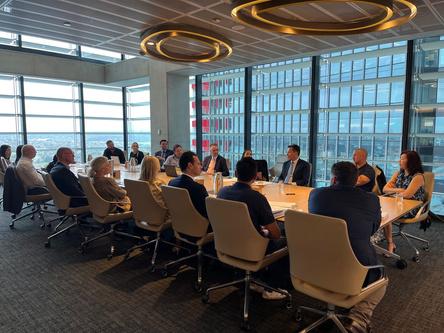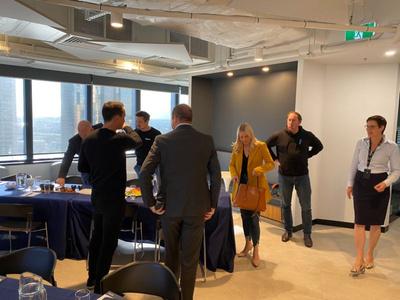Spring Spring 2022 2022
official publication of

of Professional Staffing Companies in Australia




























Since the election of the new Government the heat on the labour hire market has certainly turned up a notch and its clear that further reform will impact our industry, but here’s the thing; the term 'labour hire' has become so distinctly associated with high risk, and certainly highly litigious environments I believe it’s well past time to educate our Government about the highly nuanced world that makes up ‘labour hire’ and just why a one size fits all system is clearly not fit for purpose.
Through our new partnership with government relations firm Cornerstone Group, we intend to lobby Government to seek a carve out in legislation that will differentiate white and blue collar workforces and draw clear delineation between professional contracting and the broader casual workforce. We need education, discussion and collaboration, rather than attack, and more fearmongering.
We will commit to a roadmap of activity that will allow us to work with Government and strive for a solution that recognises the myriad of dynamics that make up todays’ modern workforce, rather than a single label that captures businesses by default rather than definition. This strategy holds a mirror to APSCo’s membership profile and clearly defines who we represent and why we are different, a topic of discussion that has surfaced continually since my appointment as MD almost three years ago, and is sometimes accompanied by “why does our industry need two member associations?”
That’s a question I find unfathomable for many reasons, fundamentally because I believe in choice, I believe choice allows customers to align with a brand that is right for them and their business, not simply because it’s the only one on offer
I believe choice is intrinsically linked to a point of difference For APSCo members it’s about belonging to a cohort that essentially operate in the same lane enabling us to guarantee that everything we offer is relevant
Our work is certainly cut out for us and we are under no illusion that there will be challenges ahead but our conviction to lift the hood on what labour hire in Australia actually looks like will offer opportunity and ultimately a solution that our Members quite rightly deserve.
LESLEY HORSBURGH APSCo Australia Managing Director
A M E S S A G E F R O M O U R M DManaging Director

After a successful in person Engage Sydney in May, Bullhorn is excited to launch Engage Sydney 2023. Engage will be back on Wednesday March 1, 2023 to bring the Australian recruitment community together, and you’re invited.
The room was buzzing in May as we all remembered what it was like to be in person at a large event. With close to 400 recruitment professionals reconnecting and learning, it was definitely a day to remember We’re looking forward to continuing the Bullhorn Engage energy in Australia and meeting in person to start 2023 off with a bang

Engage is about bringing our recruitment community together to learn from each other, learn from industry experts, and understand best practices in today’s recruitment world In a jam packed one day agenda, you’ll join hundreds of recruitment professionals to learn, engage, knowledge share, and celebrate.
can you expect from Engage 2023?
Immerse yourself in key industry trends learn from keynote speakers, agency peers and industry experts You’ll walk away with actionable ideas for your business Explore technology innovation and best practices if you’re looking for ideas on how to make the most of Bullhorn, you can meet with our local team, including Customer Success, Trainers, and Support, to receive individualised technical guidance
Hear from Bullhorn leaders and product experts you’ll learn Bullhorn best practices to make the best decisions to grow your business and get the most from your technology stack
Meet your Bullhorn Marketplace partners learn how to better utilise your current ecosystem or learn from new partners about how to address the unique challenges of your business Make new connections and reconnect with old connections reunite with old friends, make new friends, and enjoy the amazing energy that an in person conference brings.
Have fun how often does your team spend the day together away from their computers? Learn, socialise, and connect at this one day unmissable event
Whether you’re looking for industry trends, technology insights, inspiration from your peers and colleagues, or the opportunity to elevate your Bullhorn platform to the next level, Engage Sydney 2023 has it all Learn more here
M E M B E R A N D P A R T N E R N E W S
Peoplebank's latest salary index for the IT and digital industry has been released, with some interesting findings.
Compared to the previous 6 months, the Index shows:
A rise in demand in talent specifically noting Queensland, Western Australia, and South Australia
Sizeable growth in IT talent acquisition within the gaming industry
2% increase in IT professionals changing jobs since the start of this year
Approx. 10 20% rise in IT and digital salaries in most states as a result of talent shortages
Increase in opportunities and pay for junior or entry level IT professionals
The state salary data is compiled and reviewed by Peoplebank's state talent acquisition teams and is based on their experience with jobs in their region in the past 6 months
The national 3rd party data is sourced from LinkedIn Insights with top statistics summarised and highlighted with graphics.
“We develop and produce our salary guide as a resource for our clients, contractors, and candidates to equip them with a realistic view of the current market landscape. We also believe offering greater transparency around salary will support income equality,” says Brent Leahy, Executive General Manager, Peoplebank
Readers can download the salary guide here
Having just changed their name at the end of last year from Chandler Macleod Group, this is the businesses first Reconciliation Action Plan under their new brand name.
As a result of the collaboration and input from all their business subsidiaries (Chandler Macleod, Peoplebank, Vivir Healthcare, ahs hospitality and Aurion) RGF Staffing has achieved an ‘Innovate’ level RAP, endorsed by Reconciliation Australia
"The endorsement of our Reconciliation Action Plan is an exciting step for RGF Staffing It provides us with a clear direction for our business to make active contributions towards Reconciliation The development of the plan also involved commitments from our leaders and contributions from every level and department of our business. Our aim is to enhance opportunities, build relationships, and work towards a more equal and honest future," says Peter Acheson, Chief Executive Officer, RGF Staffing
Do you have a news item regarding your business? A new appointment or an exciting announcement?
Please get in touch with us here at Recruitment & Co
SEND YOUR NEWS TO CARLY@APSCOAU.ORG
M E M B E R A N D P A R T N E R N E W S
This quarter has been a very busy one at APSCo.
A change in government increased the importance that we put on our government relationships and this has increased our focus on issues in and around lobbying
Steve Smith Director, Sirius People APSCo Australia ChairAs we talk to members to firm up priorities, APSCo MD Lesley Horsburgh took a first post covid lockdown trip to Canberra and has ramped up lobbying relationships and priorities.
Through the states it has been great to see face to face membership interaction start coming back to pre covid levels, with meet ups such as the recruitment owner masterclass supported by Sovereign Private, Squire Patton Boggs and Westpac as well as online meet ups of the Finance Director network, In house Council and Medical Recruitment working groups.
NSW, Qld, Vic and ACT have all held member gatherings with Lesley and other APSCo board members. We have continued to grow our Affiliate offerings and have reached global relationships now with some Affiliates. At a local level we have been working intently with Ernst & Young, Squire Patton Boggs, LinkedIn and Westpac, in particular.
Looking forward to closing out the year, the team are busy arranging the Gala Dinner in Melbourne later in November and we will be welcoming for the first time in 3 years our Global CEO Ann Swain
For those who don't know, APSCo has a local presence in Asia, Germany and the UK, so you can feel assured you are part of something even bigger than we provide you here in Australia

As we head into the last sprint leading to Christmas, I hope everyone finishes the year off on a high and I look forward to seeing those of you who can make it, in Melbourne next month
STEVE SMITHA M E S S A G E F R O M A P S C O ' S A U S T R A L I A N C H A I R






 Our face to face member interaction is back, including new quarterly forums in Queensland, Victoria and New South Wales.
Our face to face member interaction is back, including new quarterly forums in Queensland, Victoria and New South Wales.
A S S O C I A T I O N N E W S
For as long as I can remember, Preferred Supplier Agreements (PSA’s) have been a large part of the recruitment landscape but are they now under threat?
Anthony Whyte Vice Chair APSCo Australia General Manager Talent International
There are many upsides to these agreements that benefit both parties, for example:
Agreed commercial terms of business
Set rates/margins
Smaller panel numbers (in the main)
Stronger partnerships between all parties Single point of contact Clear rules of engagement
Guaranteed volume of work
However, what we are now experiencing is that many of these PSA’s are failing to deliver due to agreed rates/margins being non competitive in the post COVID 19 era
Only a small number of clients have acknowledged the significant shift in the market, where skill shortages now exist across numerous job types and industry sectors. As a result, these clients have quickly mobilised and have increased the margins that their suppliers can charge.
This goes a long way to ensuring that they have continuity of service by receiving high levels of service and more importantly access to the top talent that they seek
Those clients who remain reluctant to do mid contract margin variations are now seeing a decline in service as recruitment firms continue to shift towards working with clients offering better margins
The math is quite simple. You have an excellent candidate where you can make $5/hour margin with client A, or make $10/hour with client B. If you wear your business hat, that candidate will end up with client B ninety percent of the time. Let’s all remember that we are in business to make money that is just the commercial reality.
As an industry, we need to continue to work with and educate our clients by being upfront and transparent.
Those clients that choose to stick to their guns and expect agencies to service them with non competitive pricing and margins will struggle to attract the talent they require
We need to continue striving for that perfect partnership where all parties get a win/win outcome
A N T H O N Y W H Y T E - T A L E N T
As we all know, demand is out stripping supply in all sectors, including the professional staffing industry. There are more jobs than trained people so what’s the answer to solving the workforce shortages in all our industries including recruitment. John McCluskey writes.
John McCluskey Director APSCo Australia Managing Director Whizdom Recruitment
Surely the first answer is to pay people more to attract them into our organisations?
But does this mean we are buying loyalty or just attracting someone through the front door, and will they stay? What happens if another enterprise offers them more a few months later, will they stay or go?
No matter how experienced someone is when they enter a new organisation there is always a period of knowledge transfer and familiarisation What happens if the person who has been loyal suddenly finds out that the new person, they are training is being paid more than what they are?
How far will their loyalty extend? So, if you bring someone new into your organisation doing a role similar to a current valued employee, we better ensure their pay is adjusted as well
One new hire could cost you many current hires if you don’t get this right, making that initial hire a very expensive cost to the business and they might not even work out.
So, are there any alternatives?
We have found for our business bringing in new people in at entry level positions and promoting within has worked better for us.
Sure, there is a greater lead time, but people are more inclined to develop and mentor junior/trainee staff, than senior peers that are paid higher.
We have also found bringing people in from other industries seeking career changes has proven rewarding and our existing staff have grown from the mentoring opportunities.
People seeking career changes are usually very grateful for the opportunity and the belief you have shown in them, and this can often be repaid to a good employer with loyalty
J O H N M C C L U S K E Y W H I Z D O M R E C R U I T M E N T
































Jimmy Rees,
Jimmy Giggle of


with
of
is a











This is a question that SEEK's Market Research Manager, Caroline North (right), has been researching for more than a decade. SEEK’s Laws of Attraction, a study of over 11,500 Australians, delves into exactly that, and in its latest iteration has revealed the top drivers for Australian candidates who are searching for their next role.
We’re in a candidate short market, which has stemmed from a reluctancy among candidates to move jobs throughout the pandemic. It’s now more important to pay attention to the data surrounding what candidates want
Here’s how using SEEK’s Laws of Attraction data portal can help you to optimise your next job ad in order to stand out from your competition
When writing effective ads, it’s important that your bullet points speak to the top three drivers that candidates in that industry are looking for For instance, Laws of Attraction reveals salary & compensation is the number one driver of attraction for the ICT industry with an importance score of 29 4%, and ICT over indexes on the importance of salary & compensation compared to other industries. Knowing this, highlighting the salary in the job ad as well as whether there is a salary review period (which 51% viewed as a must have) is imperative to attracting talent.
“Your first touch point to influence a candidate is your job ad If you clearly show you
understand their priorities, they are more likely to engage, read on, and apply” says North
It’s not enough to list the drivers of attraction the job ad needs to explain how you plan on delivering it If work life balance has a high importance score to your candidates, it’s valuable to show how your organisation facilitates this, whether it is the capability to work from home, flexible working hours or time in lieu.
In this latest study, work-life balance is where SEEK has seen the biggest shift in importance, which can be largely attributed to the pandemic unveiling the new world of work. The research shows 28% of full time employees said that the ability to work from home is a must have, while another 49% said they’d be delighted if it was offered
“People have moved on from thinking that working from home is a nice to have perk for some, to prioritising this as a must have Specifically, for traditionally office based roles, talking to flexibility has never been more important.” says North

The Laws of Attraction data portal is rich with insights, providing you with the opportunity to be targeted with the drivers you feature in your job ad to reach your hiring goals If your diversity, equity and inclusion goals focus on recruiting women in leadership positions, it’s important to recognise what key drivers apply to them. The data shows nearly one in two women prioritise roles that offer on the job skills development and coaching, while their male counterparts look for promotion opportunities (40%) as their primary driver of attraction in career development.
“At a gender level, we see differences in the importance drivers play in attraction For example, women place the most importance on work life balance, while men focus on salary & compensation as their main driver Understanding these nuances and crafting your job ad to reflect the key drivers is going to help you land the right talent for your role” says North.
With record numbers of job ads on SEEK this year, coupled with record low unemployment, optimising job ads has never been more important.
Visit SEEK’sLaws of Attraction portal for the latest insights
The Great Resignation is in full swing and it’s no surprise that candidates today are calling the shots. So here’s my question to you: what are you doing to help your recruitment agency win, not just today... but for tomorrow and beyond? Vincere's Amy Street writes.
The definition of insanity is doing the same thing over and over again and expecting different results Albert Einstein "
Top performing recruitment agencies are planning for talent shortages and tweaking how they operate.
As a recruiter, placing well suited candidates isn’t your only concern. Keeping your clients happy is also top priority.
If you can make Customer Experience your unique selling point, your agency will win more business Especially in a candidate short market, recruitment is all about building relationships and then delivering.
Audit all your customer touchpoints including Net Promoter Scores, reviews and feedback Keep an open line of comms, period This is more important than ever right now
While video can’t replace in person interaction, innovative recruitment agencies across Australia are leveraging video not just for interviews but also business development, outreach and most importantly personalized interaction with candidates and clients Think check ins with your top clients and workers

Is your job board spend increasing? Kudos to you if you know the total average spend on job boards per month What about the return on investment per job board? If you’re stumped, it’s probably time to stop throwing money at job boards.
In a candidate short market, the smarter approach is to work with what you've already got. Look inwards The last thing you want is a competitor placing a candidate you got in your database
Amy Street Head of Customer Engagement ANZ VincereIt’s time to take control of your data and transform your database into a lean and mean placement machine. All it takes are small changes that will go a long way.
Focus on skills over keywords. The right coding of skills will help you find qualified candidates quickly without the reliance of complicated Boolean strings This also helps you filter out candidates that bluff using keywords in their resumes.
Candidate pools and segmentation. Organizing your database by categories using tags like skills, location and experience will make it so much easier (and faster) for you match candidates to jobs
In order to deliver a better customer experience for clients and candidates and stand out in a competitive market, staffing agencies are increasingly taking on a wider variety of software applications
Using a central platform to support your end to end recruitment process and integrating it with other solutions is the perfect way to build a technology ecosystem that works specifically for your business
However, take care. Just as the departments within your agency need to work together to be successful, your tech needs to be well integrated for optimum performance Here are 5 things you should consider when looking to integrate your technology. FastTrack's Jason Quirk writes.

Before you look at the types of solutions available, it is important to define your business requirements for the integration remember that you're integrating systems to solve a business problem. Ensure you know the answers to the following questions to identify the best solution for your business;
·What are the expected volumes to be integrated?
·When will the data be integrated real time, on a set time interval, triggered on a user action?
Are you expecting a one way or two way integration? A two way integration is complex and it will impact the development effort and cost
·Have you mapped the data between the two systems based on your users’ expectations? This will help ensure your expectations are met.
How long do you expect this integration to be in operation? You should have a view as it will help define costs
There are two options available to you buying an existing integration solution or building a customised one.
Each has its own set of pros and cons and you need to determine what is best for your business
Firstly investigate whether an integration between the platforms already exists. The platform providers may have a Marketplace of pre built connectors you can easily enable or configure If the platform has a partnership with an integration platform like Zapier, check out if the platforms are supported.
It’s important to note that not all integrations are created
equal If your supplier does provide an integration, assess the solution’s fit against your pre defined business requirements. Then also consider:
Jason Quirk Chief Technology Officer, FastTrackOngoing maintenance and management
Understand their process for maintaining the integration between the suppliers. Ask about their service guarantee and timing of maintenance outages and plans for enhancement and continued development of the integration.
The supplier of the integration should provide a cost based on your defined requirements This is likely to be volume based or an annual/monthly service fee
Building an integration gives you 100% control and greater flexibility. Defining your requirements is again critical and will ensure you can accurately scope, size, and cost the solution. Additional considerations include:
Do the technology skills exist internally or are you contracting the skills into the business? Consider resources required beyond the initial build such as ongoing maintenance and further development.
Ensure you are building the integration in a modern technology that will service the integration for your desired timeframe. You need to do your research and understand what’s being proposed to avoid high/long term licensing or hosting costs or an old, outdated technology being used or a solution that’s not scalable for your business needs
Factor in the ongoing maintenance costs of fixing any bugs, upgrading the integration based on the suppliers of the services changing their systems, and any level of ongoing enhancement.
Based on the defined business requirements and agreed technology approach you should be able to define the forecasted development and ongoing hosting cost to determine if the development and ongoing maintenance is viable for the business.
3. Technical considerations Whether building or buying you need to understand the data you are storing or processing in the integration Have you considered the following;
Data privacy and your regional obligations for this data?
Security and ensuring this data is protected to avoid any kind of data leak?
Be sure to define a plan around your implementation covering Analysis, Design/ Development, User Acceptance Testing, and Going Live Engaging operational sponsors and subject matter experts into the project is critical to ensure you have appropriate support during and post project.
It is important to have answers to all these questions as you are responsible for the data you collect directly or indirectly. Many countries are now imposing significant penalties where incidents occur around sensitive data so don’t get caught thinking it’s someone else problem, as such incidents can be seriously harmful to a company’s reputation.
Where the data is hosted? Is it hosted in your region? The data’s term of useful life Backup / Business Continuity Plan
No matter if you buy or build you need to consider if you are you storing any data in the integration that will require you to have a backup regime in place.
Always consider how would you operate your business if the integration is offline and define a plan if it was to occur so the whole business is clear on the required actions
You should include more than one person and document the process to avoid knowledge being lost should staff move on. This is critical to the future education of new staff and supports upgrades or new releases going forward as there may be impacts to how you utilise the solution and your defined processes
Integrations can bring great efficiency by saving time and money, but they can also be costly if incorrectly implemented It’s recommended that you have a defined business case and return on investment to measure its success. If you don’t follow this practice, how do you know it’s working and that your spend of resources (time/money) is having the planned impact on the business?
By following this practice, you can monitor, and pivot as required to ensure the business does achieve the desired outcome.
Often, what might appear to be a lumpy business turns out to be just lumpy accounts. That can be a very dangerous thing. Middle Office's Thomas Taylor explains why.
 Thomas Taylor Director, Middle Office
Thomas Taylor Director, Middle Office
It’s a profit one month, a loss the next, and you get used to it being up and down You know there is business is coming in next month and hopefully that will cover it
If you graph profit, month by month, for this sort of business, it looks like the Loch Ness Monster, half in and half out of the water.
With the much higher head of the monster representing the forecast. This might be *optimism bias, and that can be dangerous, but you don’t want to plan for failure.
So, what are some of the things you can do?
First, get real about the pipeline If this has been going on for a while, call bulldust where you see it
In your discussions raise what the possible consequences should be if the targets keep being missed
This is not about blame, and it’s not at all easy or pleasant, it’s about being authentic Wanting the best outcome for everyone concerned A lumpy business cannot provide a satisfying environment for all of the stakeholders
A great Chairman I worked with years ago did this with a failing company. He got everyone to agree on what the consequences should be in 3, and in 6, months if the turnaround targets were not met. They missed them but at least everyone understood they had done the best they could.
Next look at your margins. Find out how other businesses like yours manage margins
Find out where the problems are Slice and dice margin by sector, client type, team, office, and down to individual consultant level
Compare your margins and costs with other businesses like yours Also, compare remuneration structures and amounts
Finally, try to cut back on some of the risks Try to just bet some paddocks rather than the whole farm If that means scaling back for a while that might be a good thing. Particularly if you can go through your client list and cull the less profitable ones, and let’s face it they are usually also the difficult ones.
A surf coach once told me that if you have trouble paddling out, come in a bit, move up the beach, and then catch the rip out. Then he said, “life is like that sometimes” Classic He also said, “the first thing you should do is spend some time on the beach watching carefully before you get in the water” Because for years we have known there are definitely monsters out there There is graphical proof

Some impacts from the Covid years are still to be analysed. From HHMC’s perspective, one noticeable change is the increase in micro business owners (we define as 5 or less staff) that are considering an exit. Rod Hore explains.

For years we have seen the statistics about the pending baby boomer retirement and the impact that will have on the workforce. Maybe that time is finally here.
This is big news for the recruitment industry there are possibly thousands of micro recruitment agencies with retirement age owners
How do these owners approach this event? HHMC believes each of these businesses has value. But the value is often tied into the owner, so a “traditional” sale process is unlikely to be appropriate
Here are our top tips for owners in this situation:
1 Understand that the value of your business is related to a successful transition of your revenue, staff, and clients into the new business. How easy is your business to digest for a bigger one? It is not about the multiple and is not about a substantial upfront payment larger businesses have a different sale value and deal structure
2. The sale process needs to be managed by you. Get transaction, tax, accounting and legal support, but this will be your project to run
3 The potential buyer is likely to be in your field of vision geographically close and/or operating in the same sector.
4. Start now to identify and network with potential acquirers. It is up to you to make yourself known.
5 Start now to build your support team so when needed you can move quickly
6. Start now to clean up your business. Remove non business assets and expenses; ensure contracts and compliance are current; keep your books shipshape Enjoy the process It is your pathway to your new life
As we enter into an uncertain economic period post Covid, there are a few developments we need to be aware of and things we need to implement to ensure recruitment businesses are as strong as they need to be to weather any potential downturn coming our way. Younique Coaching's Sophie Robertson explains.
Sophie Robertson Director, Younique Coaching
1.Many companies have hired rookies into the industry following our border closures. These rookies have been hired predominantly to do sourcing and candidate management Few have been trained in business development as it hasn’t been a requirement in a hot market. What may happen is that we get another exodus from the industry when some decide that business development is not for them Or some of these resourcers will get made redundant as the demand shrinks
2.Due to the job rich market, many consultants have forgotten about their client relationships and this has further been exacerbated by the fact that we have had a prolonged WFH environment, so face to face meetings have been negligible, which in turn impacts the relationship building.
Consultants need to make sure they have strong client relationships as these will be crucial when times get tough
3 As this job rich market has been predominantly perm, some companies have neglected their on hire business or it has been non existent. To recession or future proof your business, you need to have a strong temp/contractor business as part of your overall risk mitigation strategy
4. Following on from #3, if you are in the process of setting up an on hire desk, do it right from the start and have specialists look after it as perm and contract are so vastly different jobs that they require different skillsets to do them well Start as you mean to finish!
5. For candidates, it may well be the candidates who demanded and received the exorbitant salary increases who get made redundant first, if the economy really takes a dive
6 For recruiters who have never worked in a market that is candidate rich and job poor, they will get a rude shock. Don’t wait till that happens; make sure they know how to start and develop client relationships That they know how to analyse needs, give advice and really become the trusted advisor that consulting is It is always later than we think, so the time to take action on the above was yesterday but the next best time is today!
Procuret has been an Affiliate Partner of APSCo for 12 months now and in this time we have grown from an early stage fintech to successful scale up operating in Australia and New Zealand. Procuret's Zac Underwood explains.

Our business payment platform enables suppliers and service providers to offer a simple way for their clients to pay for products or services in monthly instalments, while they get paid upfront Using the latest technology, we provide a seamless digital payment solution that is fast, flexible and secure, helping suppliers and service providers to sell more, whilst getting paid sooner.
While there is a broad application for Procuret's solution, the initial focus is on products and services aimed at small and medium businesses; including recruitment agency services, where most clients currently use working capital and overdrafts to pay.
Procuret’s goal within the recruitment industry is to partner with agencies so they can work with a wider range of
businesses, without having to reduce their fees.
Over the past 2 years since targeting the recruitment industry, the uptake has been modest and we believe this is for two main reasons Both due to covid, 1) with a reduced workforce, agency recruiters have had lots of work on and haven’t prioritised these smaller businesses and 2) small medium businesses and early stage companies haven’t been recruiting as much due to market uncertainty
In a post pandemic world, we are seeing an increase in the number of companies using Procuret to pay for their recruitment fees. We have seen more recruitment invoices paid with Procuret in the last few months when compared with the 18 months prior We are seeing more and more recruitment agencies use Procuret to win new customer
segments and small and medium businesses.
Procuret can be integrated with invoicing systems such as Xero and the process doesn’t require any documents to be uploaded by the recruiter or the client The client simply clicks a secure hyperlink on the invoice, they complete the online process in a couple of minutes, approval is back within 15 minutes and the payment is made to the recruiter immediately The recruiter doesn’t pay any fees and Procuret manages the credit risk
If you would like to find out more about offering Procuret as a payment option to your clients please reach out to: Zac Underwood, Partnership Manager via zac u@procuret com
There is a currently pronounced trend in businesses using D&I recruitment strategies to future proof operations and remain competitive If you’re wondering exactly what inclusive recruitment involves, you’re not alone. Recite Me’s CEO, Ross Linnett explains.

If your company doesn’t already incorporate D&I into recruitment processes, it’s time to start The increased tendency toward remote working and WFH policies coupled with wider economic impacts like ‘The Great Resignation’ means there’s never been a greater need for teams to be able to connect, collaborate, and communicate effectively and more equitably. Even in in-office settings, D&Ibased recruitment initiatives are essential in achieving the kind of positive cultural change that improves productivity and retention and reduces absenteeism and turnover.
Checking the box on diversity hires is not enough Physical disabilities are already considered in most D&I policies However, there’s a long list of non-physical conditions that affect digital accessibility too We call these hidden disabilities Examples include vision problems, neurological differences, cognitive impairments, language issues, and learning difficulties.
Inclusive recruitment focuses on ensuring these individuals are supported throughout the candidate journey so you can hire the best talent for your teams.
Embracing individual differences makes teams stronger, more innovative and adaptable, and creates an organisational culture that fosters employee engagement and supports long term business success.
Peoplebank and Michael Page lead the way for inclusion in the Australian recruitment industry Providing additional support enables them to attract diverse hidden talent and support everyone through their digital job search.
Brent Leahy, Executive General Manager at Peoplebank commented, “The launch of the Recite Me toolbar provides candidates and clients with a more inclusive experience We want to make the Peoplebank website easily accessible to ensure all qualified candidates have equal opportunities to apply.”
At Recite Me, we’ve been working with industry leaders to compile comprehensive D&I recruitment guides and develop assistive technologies that ensure websites, intranets, and staff learning platforms are inclusive
Our most recent 12 month data shows that over 710,000 people have used the Recite Me toolbar to support their job search online. 4.5millions website pages were viewed on recruitment websites, with an average session time of 6 5 pages, 230% better than the industry average
1 Reassess existing policies to identify and address barriers to inclusion.
2. Provide an inclusive candidate journey.
3. Build diverse interviewing panels.
4. Set inclusion KPIs.
5. Invest in accessibility software.
Despite a variety of lockdowns and border closures our profession in Australia had what can only be described as a sensational year which produced a record year for a majority of our participants. Of course, there were some sectors where remote working and lockdowns just made it impossible, and the hardest hit sector was hospitality Staffing Industry Metrics' Nigel Harse writes
Nigel Harse Director, Staffing Industry Metrics
We have reviewed the performance of 81 recruitment companies and compared FY21 to FY22, and here are some of the highlights from our National Sacred Metrics Scorecard: Temp/contract sales registered median annual sales growth of 49% rising to a record high of $20.6m.
Temp/contract gross profit as a % of these sales improved throughout the year and median results lifted the return from 14.7% to 16.6% an uplift of 13%, exactly what we would expect to see in a talent tight, job rich environment
Perm placement sales was undoubtedly the most surprising winner in these unprecedented times The initial COVID breakout and lockdowns saw perm sales drop instantly by 60% but within 2 months the resurgence
began with gusto and the market has recorded a miraculous recovery with vacancy numbers breaking all records month after month Median perm sales soared from $878k per participant to $1.48m a staggering 68% growth.
These are without doubt the best market conditions I have witnessed and even though good candidates are hard to find productivity levels have flourished with Income
Producers now producing a median result of $396k, an uplift of 24% on the prior year
Median expenditure per staff member is unsurprisingly on the rise and sits at $212k, an increase of 17% on the prior year Increased wages and inflation have made their mark
At the same time, median profit per staff member has lifted 14% to $77k and smashing all prior year records
A variety of Federal and State Government interventions and cash injections provided many with a once in a lifetime cash windfall and profit boost. Unsurprisingly median profits soared 41% to a record high of $1 4m per participant
Nobody ever set out to build an average business so if you really want to know how your performance stacks up please consider participating in our safe, secure and ongoing professional survey.
Interested to know more?
Please contact Nigel Harse and mention that you are an APSCo member to receive a huge discount on your annual participation subscription.
Who would have expected the recruitment profession to thrive throughout a pandemic?
Agencies have never been more in demand and this has created a bumper year for most. I recently had a discussion with a recruitment leader who mentioned that the majority of her consultants were billing over $200,000 a year without doing any business development or client visits Justin Falk, Managing Director of TalentVine writes

We all know that this is unsustainable. A correction will come, demand will slow down and recruiters will find more of their time being put into new client acquisition. As we saw at the start of the pandemic, this creates a rush of new recruiters registering on TalentVine to supplement their deal flow Agents who had done this before the pandemic could capitalise in a more competitive marketplace as their profiles stood out compared to the newer consultants on the platform So, whilst we should certainly continue to make hay whilst the sun shines, we encourage recruitment leaders to start preparing for a shift in the market.
Working closely with these leaders has enabled us to continue evolving our product to make life easier and more profitable for recruitment agencies. Some new updates include the admin user dashboard allowing leaders to monitor how their team are benefiting from the platform, more of a focus on encouraging employers to work exclusively, some employers paying licence fees which result in agencies retaining 100% of the fee, and soon you’ll have the option to bid for retained work too

We support employers recruiting across all industries and at market agreed fees. Over the past 5 years, IT Recruitment has been the most popular industry and has steadily grown in demand.
Justin Falk Managing Director, TalentVineFrom making up 16% of roles posted to TalentVine in 2018, requests for IT recruiters now take up 33% of the share on TalentVine in 2022.
Construction and Engineering & Manufacturing talent are also in demand, growing by 126% and 56% respectively Over the past year, recruitment fees have also risen, by an average 15% increase for exclusive roles and 10% for non exclusive. In a market like this, employers struggling to find candidates on their own are willing to pay more for recruitment support
Whilst utilising TalentVine for additional deal flow is a good long term move for recruiters, there’s also no better time to jump in to access new clients and roles that match some of the positions you’re currently helping other employers to fill. Registration is free and takes less than five minutes We would love to welcome you to APAC’s leading recruitment marketplace
The Wage Inspectorate Victoria (WIV) has commenced criminal proceedings against subsidiaries of one of Australia’s largest financial institutions for underpaying long service leave entitlements, Gadens' Diana Diaz writes.

The main functions of the WIV include:
informing people about their rights and obligations under the Wage Theft Act 2020 (Vic) (WT Act); promoting, monitoring and enforcing compliance with the WT Act; and investigating and bringing criminal proceedings in relation to alleged contraventions of the WT Act.
A key employee entitlement recognised under the WT Act is the right to accrue and be paid long service leave in accordance with the Long Service Leave Act 2018 (Vic) (LSL Act) which provides that accrued but untaken long service leave entitlements are payable on termination.
In 2020, the WIV launched an investigation into Coles Supermarkets Australia (Coles). Coles pleaded guilty to seven charges, admitting that it had underpaid 24 former employees $53,710 by failing to pay out their accrued long service leave entitlements Coles was fined $50,000 plus costs of $15,000 The investigation also revealed that Coles had underpaid more than 4000 employees $700,000 in long service leave entitlements by erroneously "freezing" the accrual of long service leave during periods of unpaid leave.
This month, WIV has commenced criminal proceedings against of one of Australia’s largest financial institutions for allegedly failing to pay more than $70,000 in accrued long service leave entitlements to 20 former employees on termination.
The WIV also has proceedings afoot against other major Australian corporations and a labour hire company
This is a timely reminder for all employers regardless of size or location to ensure that they are complying with statutory long service leave obligations and to frequently audit their payroll processes and procedures. Some common pitfalls include:
failing to pay out accrued long service leave entitlements on termination; mistakenly ‘freezing’ the accrual of long service leave during certain periods of absence (e.g. depending on the applicable legislation, periods such as annual leave, parental leave and periods where employees are on workers’ compensation); incorrectly calculating the rate of pay for an employee’s long service leave entitlement, particularly when their hours of work have varied throughout their employment period; and failing to consider more beneficial entitlements under any registered agreements or pre modern awards
D&I data can include information about gender, race, ethnic origin, religion, language, socio economic background or health Employers and other organisations may want to collect and track D&I data about their staff to understand the current profile of their workforce, measure progress, assess the impact of their equal opportunity policies, and identify any organisational changes that need to be made.
There are risks in collecting D&I data due to the inherently personal nature of the information. There may be social and cultural barriers to collecting and using D&I information, as well as privacy laws and compliance obligations that an organisation wanting to collect D&I data will need to address
Organisations, even those who do not have obligations under the Privacy Act 1988 (Cth) (Privacy Act), should comply with and satisfy the Privacy Act and the associated Australian Privacy Principles (APPs), as well as obtain the consent of the individual before their personal information is collected and used (unless an exception applies). Consent must be informed, current, specific and given voluntarily.
Organisations should be aware and respect that requesting consent to use D&I data for a secondary purpose may be met with a negative reaction A collection notice in an appropriate form should be used where the organisation is collecting the information directly from the individual or from a third party
In addition to having anti discrimination and workplace behaviour policies in place, organisations should consider action plans such as investing in D&I awareness programmes and training (e.g. cross cultural awareness training and inclusive recruitment training), as well as celebrating/ acknowledging cultural and religious dates where appropriate
D&I data is considered “personal information”, and in some cases “sensitive personal information”, under the Privacy Act There are 13 APPs set out in the Privacy Act that govern the collection, use or disclosure of this information and they include the following requirements:
• information should only be collected by lawful and fair means if it is reasonably necessary for one of the organisation’s functions or activities;
• an organisation can only use or disclose personal information for the purpose for which it was collected (the primary purpose) or for a secondary purpose if an exception applies (e.g. where an individual consents to the
Kim Hodge Partner, Squire Patton Boggs
secondary purpose; would reasonably expect that it would be used for a related purpose; a permitted health situation exists; or it is authorised by an Australian law, court or tribunal);
• ensure that the personal information the organisation collects is up to date, accurate and secure; and
• the organisation must provide individuals with access to personal information held about them
Although it is preferable for consent to be obtained in respect of each separate use of personal information, in practice, the initial consent given upon entering the employment relationship is commonly relied upon
A private sector employer’s handling of employee records in relation to current and former employment relationships is exempt from the APPs where the organisation’s act or practice is directly related to (i) either a current or former employment relationship between the employer and the individual, or (ii) an
employee record held by the organisation relating to the individual
However, the employee record exemption does not cover contractors and subcontractors handling the personal information of the employees of another organisation, notwithstanding their contractual arrangements For example, the exemption is unlikely to apply to organisations that provide recruitment, or human resource management services under contract to an employer or principal.
An organisation that is a contractor or subcontractor that collects employee records about an individual from an employer must comply with the APPs in handling that information, including specific notice requirements.
Similarly, volunteers and job applicants do not fall under the employee record exemption because they are not considered to have an employment relationship

Individuals may be reluctant to provide D&I information for social and cultural reasons, which means that a one size fits all approach may not work. Due to the multicultural nature of Australian society, Australian workers can find it difficult to specify just one cultural identity or ethnicity, which means that survey questions can become quite complex
It is also important that organisations are aware and respect that individuals may be cautious when answering D&I questions about themselves Organisations should build trust and ensure that they do not when collecting and using D&I information
While D&I information does not have to be provided on an anonymous basis, collecting the data anonymously may aid in overcoming these barriers and encourage more responses
However, in small sample sizes, organisations should assess whether anonymity is compromised and the information identifies the individual, therefore constituting “personal information” that is subject to the Privacy Act and APPs.
In some circumstances, D&I reporting is compulsory For example, the Workplace Gender Equality Act 2012 (Cth) requires employers with 100 or more employees to report annually on a number of gender equality indicators to the Workplace Gender Equality Agency In addition, entities with 500 or more employees must meet the minimum standards set out under the Workplace Gender Equality (Minimum Standards) Instrument 2014 (Cth).
Disclaimer: Please note that this article is intended as a high level overview only and should not be regarded as a substitute for legal advice
Mental illness costs Australian businesses more than $39 billion every year due to loss of productivity, absenteeism, and staff turnover (Black Dog Institute, 2021) Focusing on mental health is critical for workers and bottom lines. But it is not just a good thing. It is a work health and safety obligation according to Safe Work Australia which recently released a Code of Practice on ‘Managing Psychosocial Hazards at Work’, writes Certex's Dianne Gibert.
‘One of the biggest flaws in contemporary approaches to workplace mental health is the often exclusive focus on ‘who’ is exhibiting signs of distress, rather than ‘why’ and ‘how’ the workplace may be contributing to people’s distress ’ David Burroughs, Psychological Safety Australia
Implementing Employee Assistance Programs (EAPs) and mental health awareness training is a step in the right direction, but these are only band aids on a bullet hole. The root of the problem remains unaddressed.
In fact, such ‘fixing the person’ approaches often perpetuate cycles of distress. (See diagram on page 32)
It is important to recognise that mental health illness is an outcome
Psychosocial hazards, if not addressed, lead to mental health illness
Psychosocial hazards are about identifying hazards and risks up front. This is different from mental health which seeks to treat illnesses that have already developed.
Businesses and managers need a different perspective
Reducing mental health illness is commonly seen as something outside a business’ control Leadership will implement plans and programs to address these illnesses once they arise, but they distance themselves from the causes, such as financial stress, family troubles, etc.
However, psychosocial hazards are extremely relevant to the workplace because, most often, the workplace causes or exacerbates mental health illness.
Having mentally healthy leaders is one of the most important parts of a mentally healthy workplace ’
Professor Samuel Harvey, Black Dog Institute
Businesses need to recognise that there is a lot they can do to manage psychosocial hazards.
Dianne Gibert Managing Director, Certex
Ask yourself, ‘What can we control?’
Here are some examples of psychosocial hazards in the workplace:
Are there clear roles and expectations?
Are tasks purposeful and expectations realistic?
Do workers have a say in decisions?
Are tasks highly repetitive or requiring long periods of concentration?
Are there flexible working arrangements in place?
Do co workers get along well?
Are organisational goals clear?
Are there opportunities for skill development?
Do managers act on complaints or suggestions?
Is there a balance between workers’ effort and formal and informal recognition and reward?
Are support services easily accessible?
Is everyone respectful?
All the above are risks that business can control to help prevent or exacerbate mental illnesses
Can manager mental health training reduce sickness absence among employees?
Mental illness is one of the most rapidly increasing causes of long term sickness absence.
In a randomised control trial conducted by the University of New South Wales UNSW, 88 managers within Fire & Rescue NSW were randomly assigned to participate in a fo h
After six months, these managers’ 4000 employees had significantly lower levels of sickness absence, compared to those of managers not exposed to the training The participating managers also had improved confidence in reaching out and were more likely to contact employees who were absent due to mental health problems.
Additionally, the training was associated with a return on investment of $9.98 for each dollar spent on training (remember, absenteeism, presenteeism, and compensation claims are expensive!)
This is the first study to reveal how training managers about mental health can have a direct effect in improving occupational outcomes for employees
It is also the first time a dollar figure on the value of manager mental health training has been able to be calculated.
‘With a large proportion of employees now working longer and more flexibly than in previous generations, these results are a promising sign that managers can take a more active role in assisting their employees to lead mentally healthier lives ’ Professor Sam Harvey, Black Dog Institute

According to the Australian Bureau of Statistics, close to half of all employed Australians are working from home at least once a week.
This puts enormous pressure on businesses as working from home amplifies psychosocial risks including:
Social isolation due to lack of team support and feedback
Unmanaged work hours, often excessive or inappropriate Disengagement with work and work purpose
Businesses need to recognise these inherent dangers that come from providing the opportunity to work from home.
Fortunately, all of these can be overcome
First, you need to understand and assess what the psychosocial levers, triggers, and risks are in your business.
Then ask, “Do I have a system in place to address these hazards?”
If not, businesses should implement risk management plans. However, it can be overwhelming, unfamiliar territory. So where do you start?
That’s where Certex can help!
Through our iSuite and Risk Assessment Program, Certex’s experienced team of auditors can help identify and recognise potential systematic hazards in your workplace, so you can then do something about them.
It is not about bringing in a whole new way of operating. There is no one size fits all solution when it comes to psychosocial safety. Rather, we pay close attention to the purpose and structure of your organisation to recognise key areas of risk that need to be addressed.

Such contextual approaches are much more likely to integrate seamlessly with the business and be well-received by all members
By taking a systematic approach and a serious look at the policies and procedures within a business, we can tackle mental health illness at its roots.
Feel free to reach out for more information on managing psychosocial hazards via email info@certex.com.au

